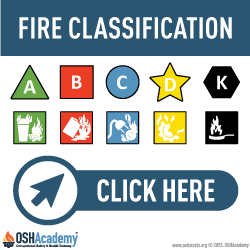Types of Fire Extinguishers
Portable fire extinguishers apply an extinguishing agent that will either cool burning fuel, displace or remove oxygen, or stop the chemical reaction so a fire cannot continue to burn. When the handle of an extinguisher is compressed, agent is expelled out the nozzle.
There are five distinct types of fire extinguishers, each designed to extinguish specific classes of fires. Modern fire extinguishers use a picture or labeling system to indicate the types of fires they are effective against. Older extinguishers, on the other hand, are identified by colored geometric shapes with letter designations.
Type A Extinguishers: Type A portable fire extinguishers are specifically designed for combating Class A fires, which involve ordinary combustible materials such as wood, paper, fabric, and plastics.
- Agent: Typically filled with water or a water-based extinguishing agent, such as foam or dry chemical, to smother and cool the fire.
- Pressure: Operated by stored pressure or cartridge-operated mechanisms, ensuring the extinguisher is readily available for immediate use.
- Size: Available in various sizes and capacities, ranging from small handheld extinguishers to larger units suitable for industrial or commercial settings. They stand about two to three feet tall and weigh approximately 25 pounds when full.
- Effectiveness: Effective at extinguishing Class A fires by removing heat and interrupting the combustion process, making them suitable for common fire hazards.
- Application: Suitable for use in environments where Class A combustibles are present, including homes, offices, schools, and other public spaces.
- Maintenance: Require regular inspection, maintenance, and servicing to ensure proper functionality and compliance with safety regulations.
These characteristics collectively make Type A portable fire extinguishers essential safety equipment for addressing fires involving ordinary combustible materials.
Type B Extinguishers: Type B portable fire extinguishers are specifically designed to combat fires involving flammable liquids such as gasoline, oil, grease, and solvents. For Class B fires, the travel distance from the Class B hazard area to any extinguisher must be 50 feet (15.2 m) or less.
- Agents: Typically contain agents like carbon dioxide (CO2), dry chemical powders (such as sodium bicarbonate or potassium bicarbonate), or foam.
- Method of Operation: Operated by either squeezing a handle or pressing a trigger to discharge the extinguishing agent.
- Effectiveness: Designed to smother the fire by removing oxygen or inhibiting the chemical reaction of the fire triangle (fuel, heat, oxygen).
- Size and Portability: Compact and portable, making them suitable for use in various locations such as kitchens, workshops, and industrial settings.
- Classification Label: Clearly labeled with a classification symbol "B" to indicate suitability for flammable liquid fires.
Type C Extinguishers: Type C portable fire extinguishers are specifically designed to combat Class C fires, which involve electrical equipment. CO2 extinguishers will frequently be found in industrial vehicles, mechanical rooms, offices, computer labs, and flammable liquid storage areas.
- Agents: Typically contain agents like carbon dioxide (CO2), dry chemical powders (such as sodium bicarbonate or potassium bicarbonate), or foam.
- Non-conductive: Type C extinguishers contain agents that do not conduct electricity, ensuring safety for the user and preventing electrical shocks.
- Precautions: CO2 extinguishers should not be used in a confined space while people are present without proper respiratory protection. They are not recommended for Class A fires because they may continue to smolder and re-ignite after the CO2 dissipates.
- Clean agent suppression: They typically use clean agents such as carbon dioxide (CO2) or dry chemical powders to suppress the fire without leaving residue or causing damage to sensitive equipment.
- Effective against energized equipment: These extinguishers are effective at extinguishing fires involving energized electrical equipment, providing a crucial safety measure in areas with electrical hazards.
- Color: CO2 cylinders are red and range in size from five to 100 pounds or larger.
- Labels: Type C extinguishers are often color-coded with a blue label for easy identification in case of an electrical fire emergency.
Knowledge Check Choose the best answer for the question.
1-4. Which class of fire involves ordinary combustible materials such as wood, cloth, paper, rubber, and many plastics.
You forgot to answer the question!

